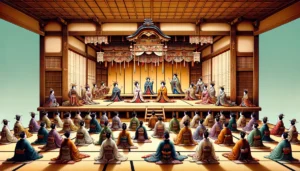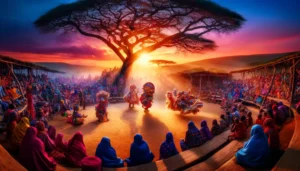
Theatre arts have a rich and diverse history that spans thousands of years. From the ancient Greek tragedies performed in open-air amphitheaters to the elaborate productions of Shakespearean plays in Elizabethan England, theatre has always been a central part of human culture. It has served as a platform for storytelling, social commentary, and artistic expression, allowing people to explore and understand the complexities of the human experience.
One of the key elements of theatre arts is acting, which involves bringing characters to life through the use of voice, movement, and emotion. Actors undergo rigorous training to develop their skills and techniques, learning how to embody different personalities, portray a range of emotions, and effectively communicate with their fellow performers and the audience.
Storytelling is another essential component of theatre arts. Playwrights and scriptwriters create narratives that engage and captivate the audience, taking them on a journey through different worlds and perspectives. The power of storytelling lies in its ability to evoke emotions, provoke thoughts, and spark conversations. Through theatre, stories can be told in a way that is both entertaining and thought-provoking, leaving a lasting impact on those who witness them.
Music is yet another integral part of theatre arts. From musicals to operas, music adds depth and emotion to the storytelling, enhancing the audience’s experience. Composers and musicians work closely with the rest of the production team to create original scores or adapt existing music to fit the narrative and enhance the overall atmosphere of the performance.
Design is a crucial aspect of theatre arts that often goes unnoticed by the audience. Set designers create the physical environment in which the story unfolds, using props, scenery, and lighting to transport the audience to different times and places. Costume designers, on the other hand, are responsible for creating the visual identity of the characters, using clothing and accessories to reflect their personalities, social status, and the historical context of the play.
Finally, the impact of theatre arts extends beyond the stage. For performers, theatre provides a platform for personal growth, self-expression, and the exploration of different identities. It allows them to develop empathy, collaboration, and problem-solving skills, as well as the ability to think creatively and adapt to different situations. For audience members, theatre offers a unique and immersive experience that can entertain, educate, and inspire. It has the power to challenge preconceived notions, broaden perspectives, and foster a sense of community and connection.
So, whether you are an aspiring actor, a theatre enthusiast, or simply someone who appreciates the magic of live performances, theatre arts has something to offer everyone. It is a world of endless possibilities, where imagination knows no boundaries and where the power of storytelling can truly come alive.
In addition to the ancient Greeks, many other civilizations have made significant contributions to the history of theatre arts. For example, in ancient Rome, theatre was a popular form of entertainment, and the Romans built grand amphitheaters where elaborate productions were staged. These performances often included elaborate sets, costumes, and special effects, showcasing the Romans’ love for spectacle and grandeur.
Furthermore, in ancient India, the art of theatre was highly developed, with a rich tradition of Sanskrit drama. These plays, known as Natya Shastra, were not only performed for entertainment but also served as a means of educating the audience about religious and moral values. The Natya Shastra laid down detailed guidelines for every aspect of theatre, including acting, stage design, and music.
Moving forward in history, the Middle Ages in Europe saw the emergence of religious plays, known as mystery plays and morality plays. These plays were performed by traveling troupes and were often staged in churches or town squares. They depicted biblical stories and moral lessons, and were an important form of cultural expression during a time when illiteracy was widespread.
During the Renaissance period, theatre arts experienced a significant revival, not only in Europe but also in other parts of the world. In Japan, for example, the traditional form of theatre known as Noh emerged during this time. Noh theatre combines elements of music, dance, and drama, and often features masked performers. It is characterized by its slow, stylized movements and poetic dialogue.
In the 19th century, theatre arts underwent another major transformation with the advent of realism. Playwrights such as Henrik Ibsen and Anton Chekhov sought to depict ordinary people and everyday life on stage, challenging the romantic and melodramatic conventions of the time. This movement paved the way for modern theatre, which continues to explore new forms of expression and tackle contemporary issues.
Today, theatre arts encompass a wide range of genres and styles, from traditional plays to experimental performance art. Technology has also played a significant role in shaping contemporary theatre, with the use of multimedia projections, virtual reality, and interactive elements becoming increasingly common. Theatre has also become more inclusive, with a growing emphasis on diversity and representation, both on and off the stage.
In conclusion, theatre arts have a rich and diverse history that spans across cultures and centuries. From the ancient Greeks to modern-day performances, theatre has continuously evolved and adapted to reflect the changing times. It remains a powerful form of artistic expression, capable of entertaining, educating, and challenging audiences around the world.
5. Directing
Directing is the art of bringing together all the elements of theatre arts to create a cohesive and impactful production. The director is responsible for interpreting the script, guiding the actors in their performances, and making creative choices regarding staging, blocking, and overall vision. They collaborate closely with the design team to ensure that the visual and auditory elements align with the storytelling. A skilled director can transform a script into a dynamic and thought-provoking theatrical experience.
6. Audience Interaction
Theatre arts thrive on the interaction between performers and the audience. Live theatre offers a unique experience where the audience becomes an active participant in the performance. The reactions and responses of the audience can influence the energy and dynamics on stage. Actors feed off the audience’s laughter, gasps, and applause, creating a symbiotic relationship that adds an element of spontaneity and excitement to each performance.
7. Collaboration
Collaboration is a fundamental aspect of theatre arts. It involves the collective effort of actors, directors, designers, technicians, and stage crew to bring a production to life. Each individual brings their unique skills and perspectives, working together to create a cohesive and harmonious performance. Effective collaboration requires clear communication, mutual respect, and a shared commitment to the artistic vision.
8. Cultural and Historical Context
Theatre arts are deeply rooted in cultural and historical contexts. Plays and performances reflect the social, political, and cultural climate of their time. They provide a platform for exploring and challenging societal norms and values. By examining theatre from different eras and cultures, we gain insight into the diverse perspectives and experiences of humanity. Theatre arts serve as a mirror that reflects and critiques the world we live in.
9. Emotion and Empathy
Theatre has the power to evoke strong emotions and foster empathy. Through the stories and characters portrayed on stage, audiences can connect with universal human experiences and gain a deeper understanding of the human condition. Theatre arts allow us to step into someone else’s shoes, to see the world through their eyes, and to empathize with their joys, struggles, and triumphs. This emotional connection can be transformative, sparking conversations and inspiring change.
10. Evolution and Innovation
Theatre arts continuously evolve and adapt to the changing times. From ancient Greek tragedies to experimental avant-garde performances, theatre has embraced innovation and pushed boundaries. Artists explore new forms, techniques, and technologies to challenge conventions and create unique theatrical experiences. This constant evolution ensures that theatre remains a vibrant and relevant art form that resonates with audiences of all generations.
The Impact of Theatre Arts
Theatre arts have a profound impact on both performers and audience members. Let’s explore some of the ways theatre arts influence individuals and society:
1. Emotional Connection
Theatre has the power to evoke a wide range of emotions in both performers and audience members. It allows people to connect with stories and characters on a deep and personal level. Through shared experiences, theatre fosters empathy and understanding, creating a sense of community among those who witness the performance.
2. Social Commentary
Theatre often serves as a platform for social commentary and reflection. It has the ability to address important social and political issues, sparking conversations and challenging societal norms. From plays like “A Raisin in the Sun,” which explores racial inequality, to contemporary works like “The Normal Heart,” which sheds light on the AIDS crisis, theatre has the power to provoke thought and inspire change.
3. Personal Growth
Participating in theatre arts can be a transformative experience for individuals. It fosters self-expression, confidence, and teamwork. Actors learn to step into the shoes of different characters, developing empathy and understanding. Theatre also provides a safe space for individuals to explore their own emotions and vulnerabilities, promoting personal growth and self-discovery.
4. Entertainment and Escape
Above all, theatre arts provide entertainment and a means of escape from the realities of everyday life. The magic that happens on stage captivates audiences, transporting them to different worlds and allowing them to momentarily forget their worries. Theatre offers a unique form of live entertainment that cannot be replicated through other mediums.
Furthermore, theatre arts have a significant economic impact on local communities. The presence of a thriving theatre scene can attract tourists and boost the local economy. Theatres often collaborate with local businesses, such as restaurants and hotels, to offer special packages and promotions, which further stimulates the local economy. Additionally, the production of a play or musical requires the hiring of actors, directors, designers, technicians, and other professionals, creating job opportunities and supporting the livelihoods of many individuals.
Moreover, theatre arts contribute to the preservation of cultural heritage. Traditional plays and performances are passed down through generations, keeping cultural traditions alive. Theatre also provides a platform for the exploration and celebration of diverse cultures, allowing different communities to showcase their unique traditions and stories. By embracing and promoting cultural diversity, theatre arts contribute to a more inclusive and tolerant society.
Lastly, theatre arts play a vital role in education. Many schools and universities incorporate theatre into their curriculum, recognizing its ability to enhance critical thinking, creativity, and communication skills. Through participating in theatre productions, students learn to work collaboratively, think outside the box, and effectively express themselves. Theatre education also helps students develop a greater appreciation for the arts and encourages lifelong learning.
In conclusion, theatre arts have a multifaceted impact on individuals and society. From fostering emotional connection and promoting social commentary to facilitating personal growth and providing entertainment, theatre arts enrich our lives in numerous ways. Whether as performers or audience members, engaging with theatre allows us to explore the depths of human experience and connect with one another on a profound level.
Here are some generalized links that can lead to educational resources or further reading on these topics:


- Ancient Greek Theatre: Explore Ancient Greek Theatre
- Shakespearean Theatre: Learn about Elizabethan Theatre


- Opera and Its Evolution: Read about the History of Opera
- Japanese Noh Theatre: Explore the Tradition of Noh Theatre

showing a detailed and vibrant scene from a Noh theatre performance in Japan during the Renaissance period - African Theatre Arts: Explore African Theatre Traditions

showing a detailed and vibrant scene from a Noh theatre performance in Japan during the Renaissance period




